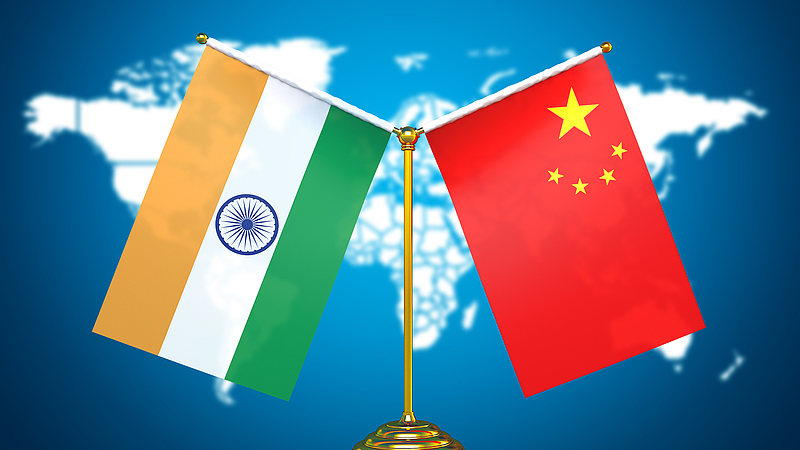By continuing to browse our site you agree to our use of cookies, revised Privacy Policy and Terms of Use. You can change your cookie settings through your browser.
I agree
Search Trends
CHOOSE YOUR LANGUAGE
- Albanian Shqip
- Arabic العربية
- Belarusian Беларуская
- Bengali বাংলা
- Bulgarian Български
- Cambodian ខ្មែរ
- Croatian Hrvatski
- Czech Český
- English English
- Esperanto Esperanto
- Filipino Filipino
- French Français
- German Deutsch
- Greek Ελληνικά
- Hausa Hausa
- Hebrew עברית
- Hungarian Magyar
- Hindi हिन्दी
- Indonesian Bahasa Indonesia
- Italian Italiano
- Japanese 日本語
- Korean 한국어
- Lao ລາວ
- Malay Bahasa Melayu
- Mongolian Монгол
- Myanmar မြန်မာဘာသာ
- Nepali नेपाली
- Persian فارسی
- Polish Polski
- Portuguese Português
- Pashto پښتو
- Romanian Română
- Russian Русский
- Serbian Српски
- Sinhalese සිංහල
- Spanish Español
- Swahili Kiswahili
- Tamil தமிழ்
- Thai ไทย
- Turkish Türkçe
- Ukrainian Українська
- Urdu اردو
- Vietnamese Tiếng Việt
Copyright © 2024 CGTN.
京ICP备20000184号
CHOOSE YOUR LANGUAGE
- Albanian Shqip
- Arabic العربية
- Belarusian Беларуская
- Bengali বাংলা
- Bulgarian Български
- Cambodian ខ្មែរ
- Croatian Hrvatski
- Czech Český
- English English
- Esperanto Esperanto
- Filipino Filipino
- French Français
- German Deutsch
- Greek Ελληνικά
- Hausa Hausa
- Hebrew עברית
- Hungarian Magyar
- Hindi हिन्दी
- Indonesian Bahasa Indonesia
- Italian Italiano
- Japanese 日本語
- Korean 한국어
- Lao ລາວ
- Malay Bahasa Melayu
- Mongolian Монгол
- Myanmar မြန်မာဘာသာ
- Nepali नेपाली
- Persian فارسی
- Polish Polski
- Portuguese Português
- Pashto پښتو
- Romanian Română
- Russian Русский
- Serbian Српски
- Sinhalese සිංහල
- Spanish Español
- Swahili Kiswahili
- Tamil தமிழ்
- Thai ไทย
- Turkish Türkçe
- Ukrainian Українська
- Urdu اردو
- Vietnamese Tiếng Việt
Copyright © 2024 CGTN.
京ICP备20000184号
互联网新闻信息许可证10120180008
Disinformation report hotline: 010-85061466




















China and India are marking the 75th anniversary of their diplomatic ties on April 1, 2025./VCG
Editor's note: Ankit Prasad is a CGTN biz commentator. The article reflects the author's views and not necessarily those of CGTN.
Ten days before the 75th anniversary of the establishment of diplomatic relations between China and India, I had the fortune of attending the annual "Vasant Mela" (Spring fair) hosted by the Indian embassy in Beijing. In the heart of the central business district of China's capital, the fair had left me pleasantly surprised with its rotundly cosmopolitan attendance. Large groups of Chinese citizens, among other nationalities not limited to Indians, enjoyed a happy gathering, dancing, eating, clicking photos and having picnicks under the first warm sunny day of the year. The event and experience was an affirmation of something I've heard of and believed for some time - that Chinese and Indians have enormous potential to get along.
At the heart of it is an almost uncanny historical symmetry between what are two ancient and accomplished civilizations. Going back into antiquity, they were linked by the Silk Road, Buddhism, maritime trade, influential dynasties, world-leading productivity and classical mathematics. In more recent history, both suffered under imperialist oppression and subsequent to that, had to navigate the tricky minefield of post-WW2 campism. Having done so skilfully to emerge as key players in a multipolar world, their reward is the potential to shape humanity's economic and developmental progress.
Mercifully, and with no small thanks to timely political decision-making between the late 1970s and early '90s, China and India's symmetry has also extended to economic advancements triggered by economic liberalization. These far-reaching reforms have contributed to hundreds of millions of people being lifted from poverty. And now, at the 75-year milestone, both nations are increasingly hinting at turning over a new leaf in their bilateral ties, possibly signaling that the best may be yet to come.
Fair-goers participate in the "Vasant Mela" organised by the Indian embassy in Beijing on March 22, 2025. /@EOIBeijing
Fair-goers participate in the "Vasant Mela" organised by the Indian embassy in Beijing on March 22, 2025. /@EOIBeijing
Fair-goers participate in the "Vasant Mela" organised by the Indian embassy in Beijing on March 22, 2025. /Ankit Prasad
Fair-goers participate in the "Vasant Mela" organised by the Indian embassy in Beijing on March 22, 2025. /@EOIBeijing
Fair-goers participate in the "Vasant Mela" organised by the Indian embassy in Beijing on March 22, 2025. /@EOIBeijing
Following last year's BRICS Summit in Kazan which signaled the end of over four years of dissonance, there has been a notable uptick in exchange of pleasantries. Speaking on at least a pair of podcasts recently, Indian Prime Minister Narendra Modi has narrated warm interactions with Chinese leadership. "For centuries, India and China have learned together, contributing to the global good. I believe our ties have been extremely strong with deep cultural connections. Our relationship should remain just as strong in the future," he said in an interview with Lex Fridman.
"Our cooperation is not just beneficial, it's also essential for global stability and prosperity. And since the 21st century is Asia's century, we want India and China to compete in a healthy and natural way," the prime minister of India proclaimed. The message from New Delhi is clear: much water has flown through the Ganges and Yangtze; it's time to work together in the right spirit for mutual benefit.
China's Foreign Minister Wang Yi replied in-kind at his press conference during China's two sessions, the annual meetings of the country's top legislature and top political advisory body in March, highlighting "China always believes that the two should be partners that contribute to each other's success. A cooperative pas de deux of the dragon and the elephant is the only right choice for both sides." Alongside, there has been some amount of action on the ground as well. The Indian foreign secretary's visit to Beijing in January yielded the decision of restarting direct flights between the two nations, essential to spurring people-to-people ties. But make no mistake, this is just the start. There is a lot of work to be done.
China's Foreign Minister Wang Yi meets India's Minister of External Affairs S Jaishankar on the sidelines of the Group of 20 Foreign Ministers' Meeting in Johannesburg, South Africa, Feb 21, 2025. /Chinese Foreign Ministry
For the two nations that each have 1.4 billion people, are soon to be home to the 2nd and 3rd largest economies globally, and share a long land-border as well as maritime space, China and India's $136 billion annual trade (2023) leaves a lot to be desired. "It should be $300 billion," said Atul Dalakoti, executive director of India's most influential trade association FICCI in China. Speaking to CGTN Business along the sidelines of the Boao Forum for Asia (BFA) Annual Conference 2025 in Hainan, Dalakoti also noted that the trade is lopsided with a trade deficit of $100 billion in China's favour. "So Indian companies can look at China and this new vigor of consumption that the Chinese government wants to push," he added.
The World Bank also recently suggested that as part of a plan for India to achieve high-income nation status by 2047, food processing is a high-potential and natural-fit sector for growth. Economics of comparative advantage suggest that this, along with India's traditional strong-suit of services, could be an avenue of export to China and Southeast Asia as a whole.
At the same time, Chinese companies have the potential to assist India in its main politico-economic priority - creating jobs and especially manufacturing jobs. Denis Depoux, global managing director of Roland Berger, predicts that Chinese companies will look to globalize further, especially amid the ongoing global tariff fluctuations triggered by the US. He told CGTN at the BFA 2025 that "One of the things that will happen very soon is that with Chinese companies sort of playing down the pure export model a bit and going to globalization through investment, they will deploy capital, but they will also deploy technology."
A vast solar power plant in Changning County, Baoshan City, Yunnan Province, southwest China, Dec 20, 2023. /VCG
Depoux especially noted solar photovoltaics and battery technologies as avenues for this Chinese globalization - both of which are enormously relevant for India which has long been reliant on costly oil imports to meet its energy needs. In 2024, India witnessed a 15.8 percent increase in its renewable installed capacity to 209.4 GW. While impressive, no nation can match China's 1889 GW (by 2024-end) installed renewable capacity, which presents the biggest hope in the battle to achieve net-zero emissions. India, with its own focus on the renewables supply chain, clearly has a lot of scope to leverage China's expertise. This would also bode well for others given India's role as a consensus builder for climate action by developing nations.
In next-gen technologies too, China and India have the opportunity to chart an era of Asian dominance. Deloitte Asia Pacific CEO David Hill noted at the BFA 2025 that China and India are world leaders in AI adoption. India's information technology minister had also recently praised China's breakthrough large language model DeepSeek for showing what the power of the brain can accomplish at low-cost, as per Reuters, adding that the open-source AI model would soon be hosted on Indian servers.
As China and India enter the final 25-year stretch to the completion of a century of diplomatic ties, which will also follow shortly after both countries turn 100 years old, the hope is they will both do so as prosperous and developed nations. With China ahead on this path, there are sure to be avenues where India doesn't need to reinvent the wheel. Eschewing the tendency to view affairs through a zero-sum prism could be the order of the day. And cooperation and the proverbial "dance of the dragon and elephant" could be the fastest and most prudent way to achieve the most significant outcomes for the most number of people.